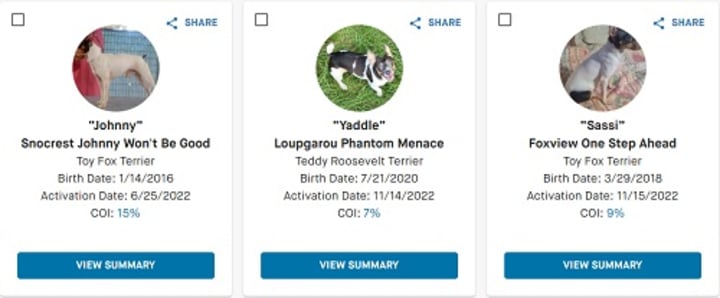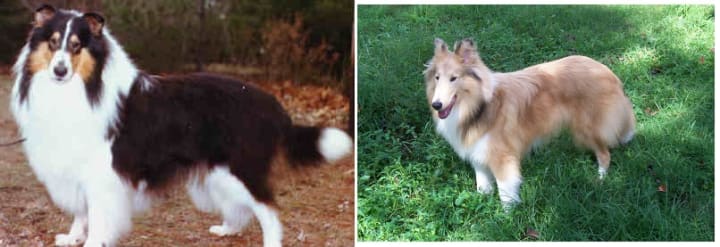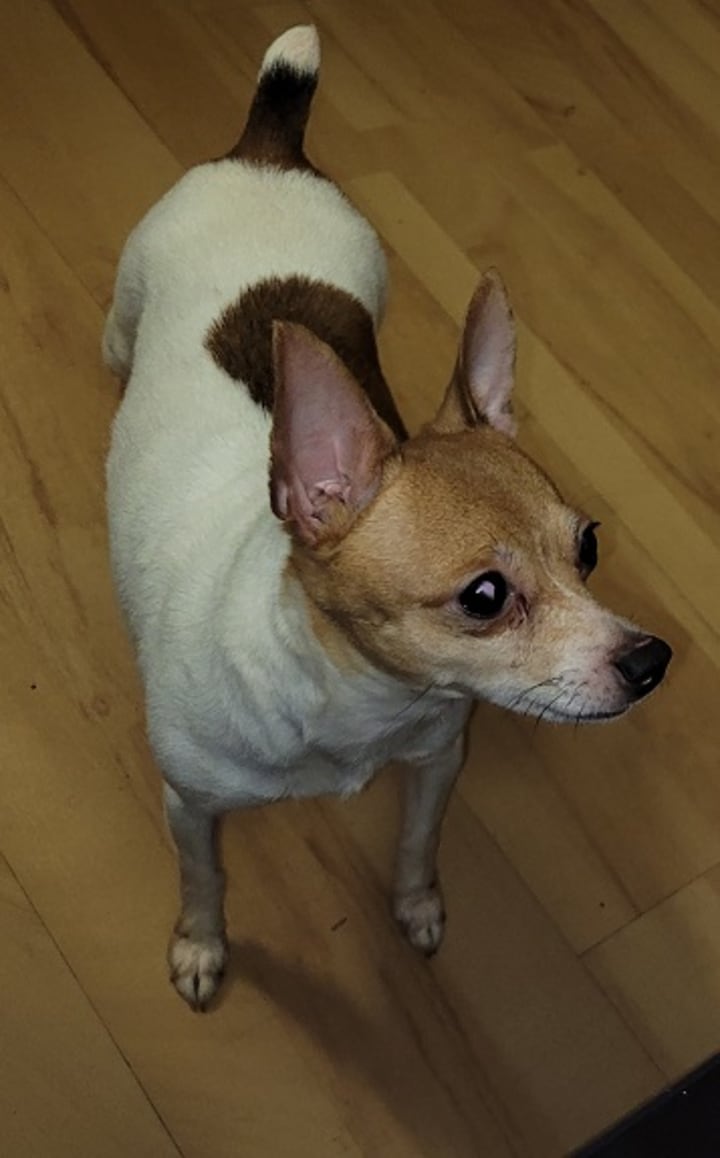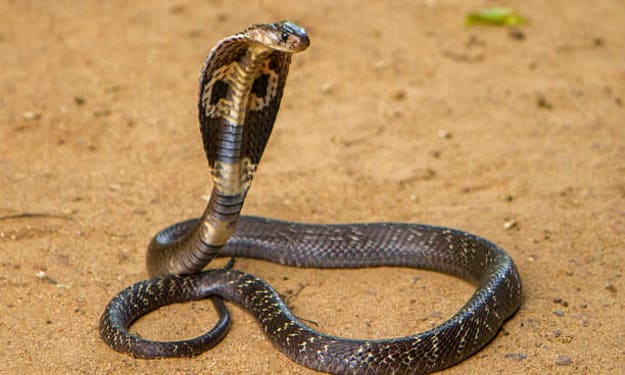On Breeding Dogs
Let me tell you a riddle: How do you make . . .

Riddle Time! How do you make a small fortune breeding dogs? You start out with a large fortune, naturally!
Many people seem to be captivated by the illusion that breeding dogs is fun, easy, and profitable. If you love dogs and like people, there is nothing more satisfying (or sadder!) than seeing a new family drive off with the puppy that you've loved for the past nine weeks. No joke: those puppies are both fun and adorable, even if they do become eating/barking/pooping machines at about six weeks of age.
Breeding dogs is rarely easy, however, and almost never profitable. Taking care of the number of dogs needed for a reasonably good breeding program is hard work. There's training, cleaning, maintaining individual diets, keeping track of weight and general health, as well as a myriad of small daily tasks. And profit? Fugedabowtit. If you're a responsible breeder who thinks of his or her dogs as more than just puppy-producing commodities, you'll do everything from genetic and physical health testing to dog shows and performance trials to maintaining a reasonable awareness of genetics and theriogenology and everything in between. The purchase price of a nice dog for breeding is only the tiny tip of a massive iceberg of annual expenses. Every dime that a responsible, ethical preservation breeder makes is pumped back into his or her dogs in one way or another.
"Recovering" Expenses?
"But a breeder will most of their expenses with one litter of puppies, won't they?" Not always. The average Toy Fox Terrier litter generally has three puppies, perhaps as many as five. Each puppy in the average litter generally weighs about four ounces, sometimes a little more, sometimes a little less. Although I know of TFTs that have had up to nine puppies, those litters are rare and usually don't survive intact. The puppies are especially tiny, usually not exceeding 2 ounces or so for a birth weight. From the moment they draw their first breaths, they are prone to hypothermia and hypoglycemia. They may need tube feeding or an incubator. The extra vet bills, time, and equipment required to keep such tiny puppies alive usually meets or exceeds the "extra profit" in sales. Even if the breeder charged $1500 per puppy, (which we don't) it's possible that he or she would barely recoup the expenses of raising such dogs, let alone make a profit.
Genetic and Physical Health Testing

Responsible and ethical breeders will both test their dogs AND make decisions according to what those tests reveal. Kathleen and I start with DNA testing (for diseases and conditions) with Embark. Right off the bat, for each dog that we retain, that's $160 each dog before they're even crawling. If a disease or a condition comes up on the scattershot Embark tests, it's off to GenSol for individual tests ($29.90 each) to confirm the results. All of our adult male dogs have been DNA profiled (for parentage) and our young male dogs will be tested this year ($50/dog AKC, $55/dog UKC). Eventually every dog we own will be both DNA profiled with both registries and tested thoroughly for genetic diseases. Fortunately, we don't have to do a lot of physical testing, but it's recommended that we test patellas and do eye, heart, and hearing testing--particularly if any issues appear in the line. People who breed larger dogs need to have OFA acceptable hip and elbow x-rays done and scored, to the cost of $250 on up per dog. Done right, screening dogs for breeding is expensive.
But that's not the end of it.
Once you have your information, you have to act on it. That stunning little dog is an SCA carrier? Do you want to "breed for replacement," breeding with a dog clear for SCA in the hopes of getting a clear dog with equal traits for use in your breeding program? What are your plans for the carriers that might be produced? That large breed dog that you just spent two years training and showing to a grand champion until OFA x-rays can be done has a grade 2 elbow and unilateral severe hip dysplasia, even though both his parents had excellent-rated hips and elbows. What do you do?
If you're smart, you'll pay attention to what the tests are telling you and retire both of those dogs to your couch or to a well-prepared pet home. All of that money will have been spent without another dime coming back to you, but you'll have done the right thing. Breeders who don't act on the information that testing provides are only testing to show that they've tested, not for the betterment of their breed.
Dog Shows--Not all Glitz and Glamor!

Anyone who has seen the movie "Best in Show" can tell you that showing dogs to big rewards is easy. Just put on the evening wear, strut around the ring a couple of times, and your dog walks away with the "blue ribbon." Every dog becomes a champion with minimal effort and expense. Wrong!
Remember Cookie and Jerry Fleck, the terrier owners from that movie? Outside of Cookie's sometimes salacious behavior, that story line gives the best vision of what "real" dog showing is all about. It's scraping together money for a hotel room and maxing out credit cards when you can't. It's about taking your dogs into small outdoor rings or onto packed dirt in horse arenas or concrete floors in multi-purpose buildings to win their championship points in the classes. It's about showing the same dog repeatedly, driving hours away from home, chasing that last point or competition win. Because nothing about showing dogs is inexpensive, not even the tiny string-like show leads we use to show our dogs. I plan to show two Teddy Roosevelt Terriers, a novice Toy Fox Terrier puppy, my English shepherd, and my Australian shepherd at the Southern Classic this year. It's a five-hour drive away in a 2001 Suburban, hotels cost $110/night, and my entry fees are going to be about $400, if I can swing it.
For all that money, I might come away with a couple of Rally obedience legs on one dog, get a reasonable evaluation of one dog that I want to breed, and maybe even introduce a puppy to shows. No evening wear, no champions, nothing but bleary eyes and a solid foundation for Goldberry's future. Keep in mind that the $400 is for one day of competition per dog. and that Goldberry costs less to enter because she's a puppy. If this were an AKC show and I had to hire a handler to help me, you could add another $200 of expenses to my expenses for that day.
Education: Breeder and Canine
Only very foolish people believe that they can breed and exhibit dogs without some kind of education. I belong to several free groups on Facebook in which we discuss genetics, share our experiences--both good and bad--whelping and raising litters, evaluate OFA x-rays, rate judging experiences, and have breed-related discussion. In addition to those freebies, though, I also participate in seminars, read books on breeding and training, and attend training classes.
Seminars can be wonderful, if expensive, experiences. They are frequently held at dog shows but are often held by training clubs and kennel clubs. Judges Panels are question and answer sessions that usually take place after best in show is over for the day. They can be free or cost as little as the price of a meal. Short seminars, held at a show, can cost as little as $75 to enter. Seminars held over several days and allow participation of dog/handler teams can cost upward of $400.
Books and educational material written by knowledgeable dog people can be expensive! A good breeder and exhibitor will at least have one or two books on his or her breed, if they are available, rule books and show standards from the registry or registries in which they show, for all sports and breeds in which they are active, and at least one book on breeding. Breeding dogs is an ongoing learning process, so magazine subscriptions and a subscription to the Dogwise book list are part of our lives. It's still possible to get a book for $10 during Dogwise's "shopworn" sale but expect to spend several times that for even an electronic book right now.
Training classes for our dogs almost go without saying. It's possible to train a puppy at home for conformation, especially if you have a dog-friendly business into which you can bring them for socialization. The average person can only go so far in dog sports without participating in specialized training classes. Obedience classes held by an actual dog trainer (with all due respect to PetSense, PetSmart, and Petco) require me to travel for two hours each way and cost $100 for seven weeks. Agility classes are the same but cost $20/day. Matches, non-championship shows, are held several times each year. O-C shows might only cost a dollar a minute to "run" your dog, but travel and entry for several dogs can be costly. Other than education, there's no "reward" for a match. No championship points are given, no legs to a performance title are earned, even at a licensed match. Unless it's a licensed match, there aren't even any ribbons!
Wellness Checks and Health Clinics
A lot of breeders do their own vaccinations at home, except for rabies vaccinations. Even so, every dog needs an annual wellness check, especially if they are very young, very old, on medication, or otherwise in need of regular medical evaluation. I'm a very happy camper: my vet still only charges $35 for office visits. She's knowledgeable about small animals and goats, she shows dogs, and she's more interested in treatment than showing off a state-of-the-art clinic. Even so, except for puppy wellness checks at three days of age, I rarely walk out of there without having spent about $100 per dog. I have *cough* several dogs, so that can add up as an annual expense. Add in flea treatment, heartworm treatment, pre-natal and post-natal care, and the costs associated with the usual coughs and scrapes and bruises experienced by dogs that regularly go outside and participate in sports, and the expenses can be substantial. Fortunately, I feed raw food and give my dogs raw bones to chew, so I don't need to do annual teeth cleaning on any of them.
Most health clinics are offered at dog shows, although some dog clubs might sponsor a microchip clinic as community service or as a fundraiser. Microchip clinics usually cost about $25/dog. Hearing, eye, and heart clinics are generally up to $75, but can be more depending on the area of the country. There are even dog fertility clinics, where you can have your male dog's "swimmers" tested for motility (activity) and numbers, then "collect" them and arrange to store them for future breeding. The entire process can cost up to $500, outside the annual storage fee, but it can be a wonderful tool for preserving the genetic code of an important sire for use after his lifetime.
Miscellaneous Equipment and Tools
There are more tchotches used in dog breeding than can be listed in this kind of article. Cat nail scissors for puppies? Check. Guillotine nail clippers for the larger dogs? Check. Baby scale for weighing small dogs? Check. Flat buckle collars and six-foot leashes for training? Check. (I have about 20 leashes, some personalized and color coded, in my car.) Show and sports leads? Check. (Same as leashes and collars.) Weight pull harnesses? Check. Surgical clamps for umbilical cords? Check. Crates? Check. (Wire, airline, playpens, ex-pens, probably a couple dozen for various uses!) Tack boxes for medications? Check. Binders for registration, health, and title certificates? Check. Grooming equipment for the long-coated dogs? Check. (I paid $75 for a pair of thinning shears last year, on sale, which I've used twice so far). Grooming table and grooming arm? Check. Jumps, weave poles, teeter for agility? Check. Miscellaneous building materials for other training equipment? Check.

Depending on your breed, you might even be in need of an incubator or a humidifier. "Coated" breeds, such as Australian shepherds, American Eskimos, and Newfoundlands, may need an additional air conditioner in their dog room or kennel and it will be running up to nine months out of the year. I even plan to add a pulley system for training coursing.
Don't forget, even if you have just one or two dogs, some of these things require multiples of everything. I have personalized six-foot biothane leashed for my competition dogs, as well as shorter leashes for walks, and light-weight leashes to transition to off-leash work. Dogs that participate in agility each have their own agility slip leash. Every dog has at least one flat buckle collar and a martingale (limited slip) collar. Show leads? I probably have several dozen of varying types, colors, and thicknesses, as I show three different sizes and weights of dogs. The English shepherd could break the one-eighth inch to one-quarter inch lead I use to show my Toy Fox Terriers without a thought. The fur-saver collar I use on the English shepherd could be used as a belt by one of the Teddies and would look clunky as heck around their necks. Even if you think you've bought all the leads and leashes you need, they break or get chewed, and it's easy to leave them behind at a show. That can hurt when you've paid upwards of $75 for a kangaroo leather show lead with minimal bling to show that specials dog.
Post-Career Care
From all of the animal rights propaganda that people read, it's become a common assumption that breeders crank as many puppies as they can from their females before tossing them into shelters. Their female dogs live miserable lives, constantly pregnant or nursing puppies, suffering sagging abdomens with dragging teats and must be "rescued" by well-meaning people who will love them and give them a soft bed and as many treats as they can eat.
I won't deny it. There are some people who treat dogs as commodities, who off-load their dogs after they're no longer fertile or cost more money to whelp and raise their puppies than they bring in. Those breeders are not preservation breeders. A responsible and ethical breeder that seeks to preserve a breed for future generations respects the lives of the animals that they have shared their lives with. Every dog gets as soft a landing as is possible for them.
The number of litters a female dog will bear is often determined by her breed. A giant breed dog might not be bred until she is four years old and might have one, possibly two, litters before she is retired at the age of six or seven. A toy-sized dog might be bred for the first time at two years old. She has more of a window of time, so she might have three or more litters before being retired at a similar age. Unless a female has a lot to contribute to the breed, she's rarely bred more than three times and is always allowed to regain her physical condition between litters. That means that the majority of females who are being shown are not being bred at that time. In addition, females of small breeds who can live from twelve to fifteen years, spend more time in retirement than they do competing or breeding--no "rescuing" necessary.
Will a breeder keep every dog? Sometimes, no. I do, although some of my dogs might go live with Kathleen and some of her dogs might come live with me. It's easy to become "over-dogged" if you keep all of your retirees and your ability to care for them may suffer. Some breeders place their retired dogs--often free of charge or for the cost of spay/neuter surgery--with family members, with junior handlers, or with families or individuals who could not otherwise afford a well-bred dog. Some dogs have wonderful "second lives" this way and go on to make incredible pets.
Some dogs, due to being special or due to needing specialized care, remain with their breeders. You may have read Cyi's story in "Not for the Faint of Heart." Her story is ongoing, from her initial seizures in April 2022, to her secondary seizures in May 2022, to her "big surprise" in January 2024. Her upkeep isn't cheap: $29/month for her medication, bloodwork twice a year, and don't forget the Cesar dog food to make the medicine go down! I spend perhaps $1000 each year to keep her happy and healthy and, unless I plan to compete with her in virtual Rally, she will never earn another title. After she is spayed this year, she will never have another puppy. Is it worth it?

Absolutely, of course it is! There will never be another Cyi. She's adorable. She's irascible. When I put her outside for exercise, she has to be "spread around" between pens, because she can be a bully, throwing around every bit of her 4.5 pounds to show everyone else who is boss. Even Cassidy gives her distance--but she will always be mine. She will always be mine. I have no care about having a fortune, large or small, and will always put my animals first. That's a promise.
This list of ways to turn a large fortune into a small one is not comprehensive. I typed this article over several days and still found things to add: grooming, workbooks and notebooks for tracking litters and training, and many other things weren't addressed, for example. But like Da Vinci said about art, this article isn't finished--only abandoned! I could go on for another week with it, but then you'd be even more bored than you are now! (Seriously, if you read this far, thank you!)
As usual, I welcome constructive comments and observations. Next time, I promise not to be so long-winded!
About the Creator
Kimberly J Egan
Welcome to LoupGarou/Conri Terriers and Not 1040 Farm! I try to write about what I know best: my dogs and my homestead. I currently have dogs, cats, dairy goats, quail, and chickens--and in 2025--rabbits! Come take a look into my life!






Comments (2)
The things you don't think about when you think "dog breeder" 😂 It sounds like a decades long chess game, where you have to plot and plan not just a few moves ahead, but all the way to the end game, which is decades away and doesn't account for the moves of your "opponent!" Also liked the distinction made between preservation breeders and those who are doing it solely for profit. That difference? It's LOVE ❤️
This kinda feels similar to me, I don't have a dog, but my I have a cat, which does similar things sometimes